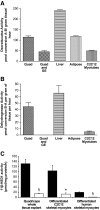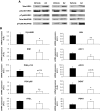11beta-hydroxysteroid dehydrogenase type 1 regulates glucocorticoid-induced insulin resistance in skeletal muscle
- PMID: 19675138
- PMCID: PMC2768185
- DOI: 10.2337/db09-0525
11beta-hydroxysteroid dehydrogenase type 1 regulates glucocorticoid-induced insulin resistance in skeletal muscle
Abstract
Objective: Glucocorticoid excess is characterized by increased adiposity, skeletal myopathy, and insulin resistance, but the precise molecular mechanisms are unknown. Within skeletal muscle, 11beta-hydroxysteroid dehydrogenase type 1 (11beta-HSD1) converts cortisone (11-dehydrocorticosterone in rodents) to active cortisol (corticosterone in rodents). We aimed to determine the mechanisms underpinning glucocorticoid-induced insulin resistance in skeletal muscle and indentify how 11beta-HSD1 inhibitors improve insulin sensitivity.
Research design and methods: Rodent and human cell cultures, whole-tissue explants, and animal models were used to determine the impact of glucocorticoids and selective 11beta-HSD1 inhibition upon insulin signaling and action.
Results: Dexamethasone decreased insulin-stimulated glucose uptake, decreased IRS1 mRNA and protein expression, and increased inactivating pSer(307) insulin receptor substrate (IRS)-1. 11beta-HSD1 activity and expression were observed in human and rodent myotubes and muscle explants. Activity was predominantly oxo-reductase, generating active glucocorticoid. A1 (selective 11beta-HSD1 inhibitor) abolished enzyme activity and blocked the increase in pSer(307) IRS1 and reduction in total IRS1 protein after treatment with 11DHC but not corticosterone. In C57Bl6/J mice, the selective 11beta-HSD1 inhibitor, A2, decreased fasting blood glucose levels and improved insulin sensitivity. In KK mice treated with A2, skeletal muscle pSer(307) IRS1 decreased and pThr(308) Akt/PKB increased. In addition, A2 decreased both lipogenic and lipolytic gene expression.
Conclusions: Prereceptor facilitation of glucocorticoid action via 11beta-HSD1 increases pSer(307) IRS1 and may be crucial in mediating insulin resistance in skeletal muscle. Selective 11beta-HSD1 inhibition decreases pSer(307) IRS1, increases pThr(308) Akt/PKB, and decreases lipogenic and lipolytic gene expression that may represent an important mechanism underpinning their insulin-sensitizing action.
Figures





Similar articles
-
Regulation of lipid metabolism by glucocorticoids and 11β-HSD1 in skeletal muscle.Endocrinology. 2013 Jul;154(7):2374-84. doi: 10.1210/en.2012-2214. Epub 2013 Apr 30. Endocrinology. 2013. PMID: 23633532
-
11beta-Hydroxysteroid dehydrogenase type 1 regulates insulin and glucagon secretion in pancreatic islets.Diabetologia. 2008 Nov;51(11):2003-11. doi: 10.1007/s00125-008-1137-2. Epub 2008 Sep 9. Diabetologia. 2008. PMID: 18779947
-
Glucocorticoids and 11β-HSD1 are major regulators of intramyocellular protein metabolism.J Endocrinol. 2016 Jun;229(3):277-86. doi: 10.1530/JOE-16-0011. Epub 2016 Apr 5. J Endocrinol. 2016. PMID: 27048233 Free PMC article.
-
The cortisol-activating enzyme 11β-hydroxysteroid dehydrogenase type 1 in skeletal muscle in the pathogenesis of the metabolic syndrome.J Steroid Biochem Mol Biol. 2017 Nov;174:65-71. doi: 10.1016/j.jsbmb.2017.07.030. Epub 2017 Jul 29. J Steroid Biochem Mol Biol. 2017. PMID: 28765040 Review.
-
11beta-hydroxysteroid dehydrogenase type 1 and obesity.Front Horm Res. 2008;36:146-164. doi: 10.1159/000115363. Front Horm Res. 2008. PMID: 18230901 Review.
Cited by
-
11β-Hydroxysteroid dehydrogenase type 1 (11β-HSD1) inhibitors still improve metabolic phenotype in male 11β-HSD1 knockout mice suggesting off-target mechanisms.Endocrinology. 2013 Dec;154(12):4580-93. doi: 10.1210/en.2013-1613. Epub 2013 Oct 29. Endocrinology. 2013. PMID: 24169553 Free PMC article.
-
Glucocorticoid-Induced Fatty Liver Disease.Diabetes Metab Syndr Obes. 2020 Apr 16;13:1133-1145. doi: 10.2147/DMSO.S247379. eCollection 2020. Diabetes Metab Syndr Obes. 2020. PMID: 32368109 Free PMC article. Review.
-
Circadian Clock Desynchronization and Insulin Resistance.Int J Environ Res Public Health. 2022 Dec 20;20(1):29. doi: 10.3390/ijerph20010029. Int J Environ Res Public Health. 2022. PMID: 36612350 Free PMC article. Review.
-
Effects of 11β-hydroxysteroid dehydrogenase-1 inhibition on hepatic glycogenolysis and gluconeogenesis.Am J Physiol Endocrinol Metab. 2013 Apr 1;304(7):E747-56. doi: 10.1152/ajpendo.00639.2012. Epub 2013 Feb 12. Am J Physiol Endocrinol Metab. 2013. PMID: 23403942 Free PMC article.
-
Effect of glucocorticoid-induced insulin resistance on follicle development and ovulation.Biol Reprod. 2013 Jun 20;88(6):153. doi: 10.1095/biolreprod.113.107862. Print 2013 Jun. Biol Reprod. 2013. PMID: 23616591 Free PMC article.
References
-
- Van Staa TP, Leufkens HG, Abenhaim L, Begaud B, Zhang B, Cooper C: Use of oral corticosteroids in the United Kingdom. Q J Med 2000;93:105–111 - PubMed
-
- Larsson H, Ahren B: Short-term dexamethasone treatment increases plasma leptin independently of changes in insulin sensitivity in healthy women. J Clin Endocrinol Metab 1996;81:4428–4432 - PubMed
-
- Fraser R, Ingram MC, Anderson NH, Morrison C, Davies E, Connell JM: Cortisol effects on body mass, blood pressure, and cholesterol in the general population. Hypertension 1999;33:1364–1368 - PubMed
-
- Tomlinson JW, Walker EA, Bujalska IJ, Draper N, Lavery GG, Cooper MS, Hewison M, Stewart PM: 11β-hydroxysteroid dehydrogenase type 1: a tissue-specific regulator of glucocorticoid response. Endocr Rev 2004;25:831–866 - PubMed
-
- Lavery GG, Walker EA, Draper N, Jeyasuria P, Marcos J, Shackleton CH, Parker KL, White PC, Stewart PM: Hexose-6-phosphate dehydrogenase knockout mice lack 11β-hydroxysteroid dehydrogenase type 1-mediated glucocorticoid generation. J Biol Chem 2006;281:6546–6551 - PubMed
Publication types
MeSH terms
Substances
Grants and funding
LinkOut - more resources
Full Text Sources
Medical
Molecular Biology Databases
Research Materials
Miscellaneous

